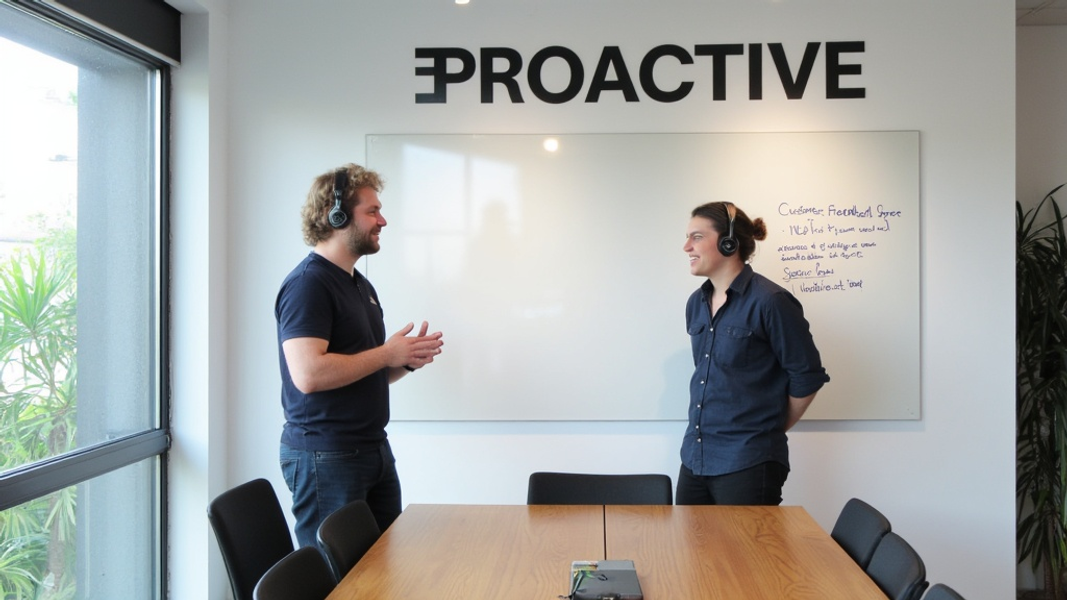
Did you know that companies with strong customer engagement see a 23% increase in revenue compared to their less engaged counterparts? This eye-opening statistic highlights the critical role that customer engagement plays in business success. In this post, we'll explore actionable strategies to boost customer engagement and loyalty, helping you build stronger relationships with your customers and drive long-term growth.
What is Customer Engagement?
Customer engagement is the ongoing interaction between a company and its customers. It goes beyond simple transactions and focuses on building meaningful relationships. Engaged customers are more likely to stick around, spend more, and recommend your business to others.
It's important to note that customer engagement differs from marketing. While marketing aims to attract new customers and promote products or services, engagement focuses on nurturing existing relationships and creating value for customers throughout their journey with your brand.
The Power of Engaged Customers
Engaged customers are the lifeblood of any successful business. They're not just passive buyers; they're active participants in your brand's story. These customers are more likely to:
- Make repeat purchases
- Try new products or services
- Provide valuable feedback
- Become brand advocates
By fostering strong customer engagement, you're not just boosting short-term sales; you're laying the foundation for sustainable growth and success.
Benefits of Strong Customer Engagement
Investing in customer engagement can yield significant returns for your business. Let's explore some of the key benefits:
Increased Customer Loyalty
When customers feel valued and connected to your brand, they're less likely to switch to competitors. Engaged customers develop an emotional attachment to your company, making them more resistant to price-based competition and more forgiving of occasional mistakes.
Higher Customer Lifetime Value
Engaged customers tend to stick around longer and spend more over time. They're more likely to upgrade their purchases, try new products, and make repeat purchases. This increased loyalty translates directly into higher customer lifetime value (CLV), a crucial metric for long-term business success.
Positive Word-of-Mouth Marketing
Happy, engaged customers are your best marketers. They're more likely to recommend your products or services to friends, family, and colleagues. In today's digital age, these recommendations can spread quickly through social media and online reviews, amplifying their impact and helping you attract new customers at a lower cost.
7 Winning Customer Engagement Strategies
Now that we understand the importance of customer engagement, let's dive into seven proven strategies to boost engagement and build stronger customer relationships.
1. Develop a Comprehensive Onboarding Process
First impressions matter, and a well-designed onboarding process can set the stage for long-term engagement. Here's how to create an effective onboarding experience:
Start with personalized welcome emails that introduce your brand and set expectations. These emails should be warm, friendly, and provide clear next steps for getting started with your product or service.
Offer interactive product tours to help new customers familiarize themselves with your offerings. These tours can be in the form of video tutorials, step-by-step guides, or even gamified experiences that make learning fun and engaging.
Set early success milestones to help customers see value quickly. These small wins can boost confidence and motivation, encouraging continued engagement with your brand.
Remember, the goal of onboarding is not just to educate customers about your product, but to make them feel welcomed and valued from day one.
2. Leverage Data for Personalization
In today's data-driven world, personalization is key to standing out and keeping customers engaged. Here's how to use data effectively:
Collect and analyze customer data from various touchpoints, including website interactions, purchase history, and support tickets. This data can provide valuable insights into customer preferences and behavior.
Use this information to segment your customers based on factors like purchase history, engagement level, and demographics. This segmentation allows you to tailor your communications and offerings to specific groups.
Deliver personalized content and recommendations based on these segments. For example, you might send targeted email campaigns with product suggestions based on past purchases, or customize your website content to highlight features that are most relevant to each user.

3. Implement an Omnichannel Approach
Modern customers expect a seamless experience across all touchpoints. An omnichannel approach can help you meet these expectations:
Provide a consistent experience across all platforms, including your website, mobile app, social media channels, and physical stores (if applicable). This consistency helps build trust and makes it easier for customers to interact with your brand.
Enable seamless transitions between channels. For example, a customer should be able to start a support chat on your website and continue the conversation via email without having to repeat their issue.
Optimize for mobile engagement. With more people using smartphones as their primary device, ensuring a great mobile experience is crucial. This includes having a responsive website design, a user-friendly mobile app, and mobile-optimized email campaigns.
4. Create Valuable Content
Content is a powerful tool for engaging customers and providing ongoing value. Here's how to leverage content effectively:
Develop educational resources that help customers get the most out of your products or services. This could include how-to guides, video tutorials, or in-depth blog posts addressing common questions or pain points.
Share user-generated content to showcase real customer experiences and build social proof. This could include customer reviews, testimonials, or social media posts featuring your products.
Craft compelling storytelling that resonates with your audience. Share your brand's mission, values, and behind-the-scenes glimpses to help customers feel more connected to your company.
5. Encourage Two-Way Communication
Engagement is a two-way street. Encourage open dialogue with your customers:
Actively seek customer feedback through surveys, polls, and direct outreach. This shows customers that you value their opinions and are committed to improving their experience.
Respond promptly to inquiries and concerns across all channels, including social media, email, and support tickets. Quick, helpful responses can turn potential negative experiences into positive ones.
Host virtual events and webinars to connect with customers in real-time. These events can provide valuable information, showcase new products, or simply offer a space for customers to ask questions and interact with your team.
6. Gamify the Customer Experience
Gamification can make engagement fun and rewarding for customers:
Implement loyalty programs that offer points or rewards for various actions, such as making purchases, referring friends, or engaging with your content. Sephora's Beauty Insider program is a great example of an effective loyalty program that keeps customers coming back.
Create challenges and competitions that encourage customers to engage more deeply with your brand. This could be as simple as a social media photo contest or as complex as a multi-week challenge related to using your product.
Offer badges or levels for engagement milestones. This taps into people's natural desire for achievement and can encourage ongoing interaction with your brand.
7. Proactively Address Customer Needs
Don't wait for customers to come to you with problems. Be proactive in addressing their needs:
Use predictive analytics to anticipate issues before they arise. This could involve analyzing usage patterns to identify customers who might be at risk of churning, or predicting when a customer might need to reorder a product.
Offer proactive support and solutions. For example, you might reach out to customers who haven't used a key feature of your product to offer assistance or send maintenance reminders before they're needed.
Continuously improve based on customer insights. Use the data and feedback you collect to refine your products, services, and customer experience over time.

Measuring Customer Engagement Success
To ensure your engagement strategies are effective, it's crucial to track key metrics and use the right tools for monitoring.
Key Metrics to Track
-
Customer Satisfaction Score (CSAT): This metric measures how satisfied customers are with a specific interaction or their overall experience with your brand.
-
Net Promoter Score (NPS): NPS gauges customer loyalty by asking how likely customers are to recommend your brand to others.
-
Customer Lifetime Value (CLV): This metric estimates the total revenue a customer will generate over their entire relationship with your company.
Tools for Monitoring Engagement
Several tools can help you track and analyze customer engagement:
-
Customer feedback platforms like Qualtrics or SurveyMonkey can help you collect and analyze customer feedback at scale.
-
Analytics software such as Google Analytics or Mixpanel can provide insights into customer behavior on your website or app.
-
Social media listening tools like Hootsuite or Sprout Social can help you monitor and respond to customer interactions across social platforms.
Case Studies: Successful Customer Engagement Strategies
Let's look at some real-world examples of companies that have excelled in customer engagement:
Spotify's Personalized Year-in-Review
Spotify has mastered the art of personalization with its annual "Wrapped" feature. This year-end recap provides users with a fun, shareable summary of their listening habits. By turning user data into an engaging, personalized experience, Spotify boosts user engagement and encourages social sharing.
Amazon's Customer-Centric Approach
Amazon is known for its relentless focus on customer satisfaction. From its easy-to-use interface to its efficient customer service, Amazon consistently puts the customer first. Their "Customer Obsession" principle has driven innovations like one-click ordering and personalized recommendations, setting a high bar for customer engagement in e-commerce.
Sephora's Beauty Insider Program
Sephora's Beauty Insider loyalty program is a prime example of effective gamification. Members earn points for purchases, which can be redeemed for rewards. The program also offers exclusive events, early access to products, and personalized recommendations, creating a comprehensive engagement strategy that keeps customers coming back.
Conclusion
Strong customer engagement is no longer a nice-to-have; it's a must-have for business success. By implementing these strategies - from personalized onboarding to proactive support - you can build stronger relationships with your customers, increase loyalty, and drive long-term growth.
Remember, customer engagement is an ongoing process. Continuously collect feedback, analyze your results, and refine your approach. With dedication and the right strategies, you can create a loyal customer base that not only buys from you but also advocates for your brand.
Frequently Asked Questions
How long does it take to see results from customer engagement strategies?
The timeline for seeing results can vary depending on your industry, customer base, and the specific strategies you implement. Some tactics, like personalized welcome emails, can show immediate improvements in engagement. Others, like loyalty programs, may take several months to demonstrate significant results. Consistency and patience are key.
Can small businesses implement these strategies effectively?
Absolutely! While some strategies may require more resources, many can be adapted for businesses of any size. Small businesses often have an advantage in creating personal connections with customers. Start with the strategies that align best with your resources and customer needs, and scale up over time.
How often should we survey our customers for feedback?
The frequency of customer surveys depends on your business model and customer interactions. For frequent purchases or interactions, quarterly surveys might be appropriate. For less frequent engagements, annual surveys could suffice. The key is to find a balance between gathering valuable feedback and avoiding survey fatigue.
What's the best way to handle negative feedback from customers?
Negative feedback, while challenging, is an opportunity for improvement. Respond promptly and empathetically, acknowledging the customer's concerns. Take the conversation offline if needed to resolve the issue. Use the feedback to identify and address underlying problems in your products or processes. Turning a negative experience into a positive one can significantly boost customer loyalty.
How can we encourage employees to prioritize customer engagement?
Creating a customer-centric culture starts from the top. Lead by example and make customer engagement a core company value. Provide training on engagement strategies and tools. Recognize and reward employees who excel in customer engagement. Consider incorporating customer satisfaction metrics into performance evaluations to reinforce its importance.
